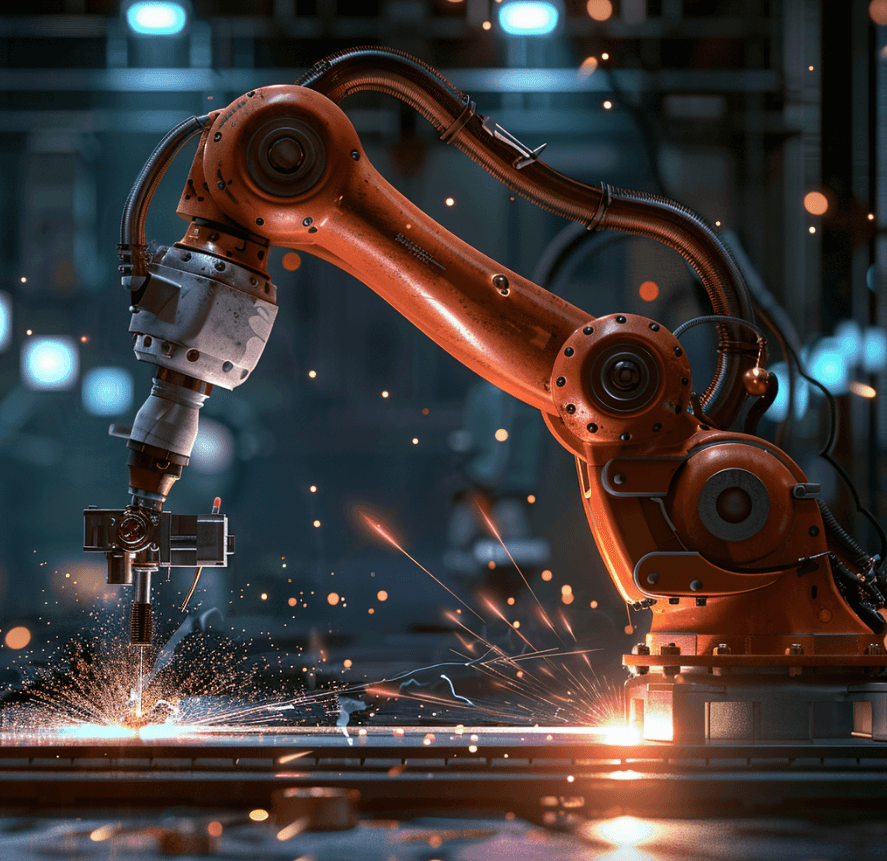

Robotic spot welding uses automated robots to perform resistance spot welds on metal components.
As you know, resistance spot welding works by passing an electrical current through the metal pieces to generate heat and melt the materials, fusing them together.
The spot welding robot arm positions the welding gun over the weld joint. The gun contains copper electrodes that clamp down on both sides of the metal pieces under high pressure.
When the robot arm triggers the welder, it releases a short burst of high-amperage, low-voltage electricity, generating intense heat and creating the weld nugget.
So, how are robots making automated spot welding possible? Let’s take a closer look:
First, we’ll look at the welding process. The spot welding robot positions the welding gun over the pieces of metal to be joined. It then presses the gun against the metal with a pre-programmed amount of force and delivers an electric current. This heats up the metal pieces, melting them together at the point of contact. Once the weld is done the robot retracts the gun.
Second, we’ll focus on heat and pressure. Spot welding robots are very precise. They can control the amount of heat and pressure applied during welding to produce consistent, high-quality welds. The robot's welding controller adjusts the current, voltage, and weld time based on the thickness and type of metal being welded. It also delicately controls the force the robot applies to get good contact between the pieces without bending the metal.
Spot welding robots can work at tremendously high speeds, completing multiple welds per minute. They’re also highly repeatable, performing the same welding sequence precisely the same way each time. This repeatability and speed, combined with their ability to work continuously with zero breaks, allows Spot Welding robots to dramatically increase productivity and throughput.
Still not sold on the benefits of spot welding robots?
Let’s take a look at some of the highlights that make them so great:
Note: Keep in mind that a lot of the usual safety concerns associated with robots can be addressed by opting for a "collaborative robot," or Cobot, like RO1. These types of robots are equipped with integrated collision detection and emergency halt features. Still, it's important to assess potential risks when utilizing welding robots

Spot welding robots, while a huge investment, offer long-term returns in efficiency and product quality that many manufacturers find not justifiable, but desirable.
When thinking about going for a spot welding system, you’ll need to factor in both the initial outlay and the continuous operating expenses.
Here's what to mull over first:
All in all, most companies budget at least $50,000 to $500,000 for a complete robotic spot welding setup, depending on the number of robots and complexity.
So, while the upfront costs of automation can be significant, robotic spot welding systems can provide major cost savings through improved productivity, quality, and safety over the lifetime of the equipment. And, a sweet ROI of 1-3 years to boot!
Once you’ve decided to automate your spot welding operations, it’s time to figure out how to actually implement robotic spot welding in your fab shop.
There are a few steps to keep in mind before you make a purchase:
With some research, planning, and investment, implementing robotic spot welding can be like a lightning bolt for your fab shop's production.
First, start by evaluating your needs, budget, and capabilities. Then, reach out to integrators and manufacturers to spec the right system.
With diligent setup, training, and safety protocols, you'll be cranking out consistent, quality welds in no time!
Ready to overhaul your spot welding operations with cutting-edge automation? Standard Bots' RO1 is a standout in Six-Axis Articulated robot arm technology, ideal for expanding fab workshops and industry heavyweights alike.
Our expert team is ready to guide you through integrating RO1's innovative features into your workflow. Experience the difference with a 30-day trial, risk-free!